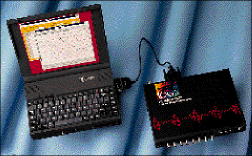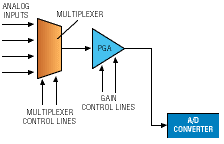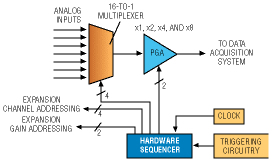PC-based test instruments:
Selecting the right
technology saves time
Digital signal processing and
other technologies used in PC-based
instrumentation are the basis
for features that make the engineer's job easier
BY GEORGE SCHERMA
IOtech
Cleveland, OH
PC-based test instrumentation, by which data acquisition electronics are married to a PC for processing power and user interface, covers a broad category of devices. Between one product and the next, the difference in features is based primarily on the underlying technology. By understanding the technology inside, the engineer can evaluate the features on the outside and avoid system weaknesses that can burn up valuable project time.

PC-based test instrumentation products–like the WaveBook/512
data acquisition system shown here–offer a variety of features and
performance to make the user's job easier.
Multiplexing
Multiplexing technology is widely used in PC-based test instrumentation (see Fig. 1 ). The idea has been around since the first engineer had two signal inputs and only one single-channel instrument on which to make a measurement.

Fig. 1. The multiplexer is a fast switch that directs
multiple input signals to the A/D converter for digitizing.
Since the first manual switch, test equipment has evolved into high-speed digital selectors capable of switching millions of times per second. Multiplexing–also called “scanning” or “muxing”–can be implemented using two approaches: either reed relay or solid state.
Reed-relay-type systems have been around the longest. They offer sealed contacts and switching speeds exceeding 500 Hz. Solid-state switching networks are a more recent innovation; they started with field-effect transistors and evolved into IC switching arrays and multiplexers.
Although IC multiplexers offer high switching speeds and a virtually infinite number of switching cycles, they are limited to an input signal range of about –10 V to +10 or +20 V. In contrast, a reed relay can switch hundreds of volts while providing high channel-to-channel isolation.
The inevitable drawbacks of mechanical reed-relay systems include a finite scanning life and limited scanning speeds. As a result, their application is usually limited to measuring slow physical phenomena. In applications with bumps, grinds, rattles, or shakes, an acquisition rate is required which can easily exceed that of a reed-relay system.
For example, assuming an engineer wants to see a waveform visually, a simple eight-channel application with 2-kHz frequency components calls for a sample rate 10 times the highest frequency–which pushes the required aggregate scan rate to 160 kHz (eight channels x 2 kHz x 10 samples/Hz)! This exceeds the maximum rate of most PC-based data-acquisition products on the market today.
There is more to multiplexing than whether it uses reed-relay or solid-state techniques. For example, a solid-state multiplexer is no guarantee of fast throughput to the computer. The unit's architecture needs to be considered, as well. The two most important considerations are the gain-selection method and the mechanism used to sequence through the channels.
Gain selection
Almost without exception, a test requires more than one gain setting. Yet with many inexpensive PC-Card, plug-in-board, or parallel-port systems, all the channels are set to the same gain. In other words, all of the channels of the product are set at ±5 V, or ±2.5 V, or some other gain setting.
In like manner, all channels are set for either unipolar or bipolar mode. This can become a problem when integrating transducers for multiple signal types where each transducer manufacturer has selected a different output voltage.
Generally, as users move up the product-price curve, they begin to see products offering programmable channel gains. As the name implies, programmable gain means that the gain can be set through software.
However, some programmable products (typically those under $500) are no better than products with physical jumpers because all the channels are set to the same gain. While they do allow the user to change gain when sequencing through each channel, the software overhead needed to accomplish this–especially in Windows where latencies can run into the hundreds of milliseconds–typically limits throughput to a couple of kilohertz.
Channel sequencing
The solution to this dilemma is to purchase an acquisition product with a channel sequencer built right into the hardware. A channel sequencer is a memory device coupled with support circuitry that drives the system multiplexer and programmable-gain amplifier (see Fig. 2 ).

Fig. 2. In a multiplexer scheme with sequence-selectable gain,
the gain for each channel is individually programmable and is
controlled in the hardware.
Before the acquisition begins, the software pre-loads the sequencer with a list of channels to be sampled plus the gain and range (unipolar/ bipolar setting) for each channel. When the acquisition starts, the hardware tracks which channel needs to be sampled and what the gain should be on each channel.
Another benefit of having a channel sequencer is that channels can be sampled in any order. This gives the engineer the ability to “move” channels without physically touching the cables, in order to reduce interchannel skew on timing-critical channels. It also allows channels to be sampled multiple times within the same scan sequence (see Fig. 3 ).

Fig. 3. Multiplexing technology such as that used in IOtech's WaveBook/512
data-acquisition system allows channels within a scan group to be scanned in any order.
Channels can also be individually programmed for polarity and gain settings.
Despite the drawbacks of using a low-cost PC-based data-acquisition system that lacks true per-channel programmable gains and a channel sequencer, there are applications where these limited solutions work fine, provided the engineer has the time to compensate for these weaknesses with extra software or different cabling. But seldom do engineers have the luxury of designing a test system to do just one job. Engineers today work on multiple projects simultaneously, and the test equipment is frequently reconfigured for new tests or time-shared by multiple people.
Trend toward intelligence
Fortunately, the trend in PC-based data acquisition is to put more intelligence in the hardware and rely less on the PC software to tell the hardware what to do. Because gain control and channel sequencing are no longer controlled by the software, less software is required to configure the instrument, making it easier to operate.
Furthermore, system throughput speeds can increase substantially. For example, the multiplexing speed of portable data-acquisition systems such as IOtech's WaveBook/512 have increased to hundreds of kilohertz per channel. What's more, high-speed data transfer under the new scheme is more reliable and independent of the PC's clock.
Intelligent architecture takes into account the need for preset individual channel gains, the ability to reorder the channel sequence, and the need to mix analog and digital inputs, as well as the ability to select an optimum operating range and the need to support seamless channel expansion. In addition, channel expansion can include integrated signal conditioning for strain, thermocouples, accelerometers, or a wide assortment of inputs that can be connected directly to the system without bulky external signal conditioners. This greatly reduces the time needed to configure a system and minimizes the errors associated with getting the parts to talk together.
Programmed channel selection allows time-critical channels to be placed adjacent to each other without physically moving wires. Individual channels can be optimized for operating in unipolar or bipolar mode and at a gain best suited for the transducer output. Once the hardware sequencer is preloaded, the software is not encumbered with doing anything other than extracting data from the acquisition hardware; everything else happens in hardware, so there is no problem with speed degradation or indeterminate timing.
A side benefit of the newer designs is that they tend to be interconnect friendly. Built-in intelligence enables the products to auto-configure when new options are added, thus eliminating the need for jumpers and reducing user-induced configuration errors. In addition, many of the new designs have eliminated problem-prone calibration potentiometers. Instead, digital correction is implemented on-the-fly by either the internal microprocessor or by digital signal processing (DSP).
In IOtech's WaveBook/512 data acquisition system, for example, the DSP design keeps the system in calibration by correcting for offsets and thermal drift on a channel-by-channel basis. It also provides sophisticated multichannel triggering while allowing the system to sample at its full 1-MHz rate.
Advertisement





